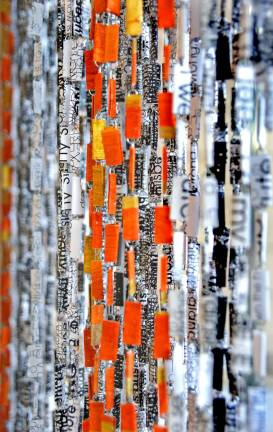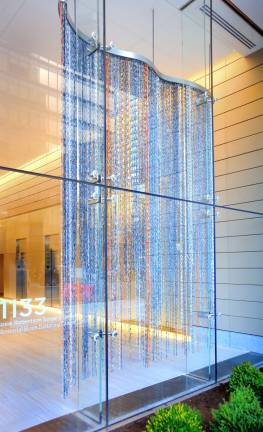Taking care of the spirit


When Brendan Ogg, an aspiring writer on the cusp of adulthood, was diagnosed with terminal brain cancer, he drew on his love of writing to deal with his hardship. Now his work, and his words, will inspire countless others facing serious illness.
Brendan was just 20 years old when he died in February of 2010, but his words and spirit live on through a series of art installations created using a collection of his posthumously published poetry.
Brendan grew up in a Maryland suburb and graduated from Albert Einstein High School in 2007 before going on to major in English at the University of Michigan. He was always a writer, writing both prose and poetry since he was 7. It was during his sophomore year in college, when he began to have headaches, that doctors found a tumor.
After five brain surgeries early in his treatment, Brendan began rehabilitation at Johns Hopkins Hospital in Baltimore before moving to the Smith Center for Healing and The Arts in Washington, D.C. It was there that he attended a poetry workshop, where he wrote some of his most powerful poems.
“What that did for him was remind him that he has this gift,” said his mother, Jackie Ogg. “He said ‘Who knows if I have a month, a year, or 10 years, this is what I want to be doing, getting back to school, taking poetry classes.’”
By the time the tumor grew back 14 months later, Brendan had impressed a number of people with his writing. Eventually, a collection of his poems, “Summer Becomes Absurd,” was published by Finishing Line Press.
“In the ripple of people that he touched were two of our artist friends, Francie Hester and Lisa Hill,” said Jackie, a board member for the Smith Center and the cofounder and contributor for the project-based community Words as Legacy. “Lisa did an abstract rendering of Brendan’s chapbook and they both created a series of art installations inspired by Brendan’s work.”
“Wordfall,” the initial exhibition in New York, was installed in the lobby of the Josie Robertson Surgery Center at Memorial Sloan Kettering Cancer Center on York Avenue and unveiled in December.
“Wordfall” is comprised of more than 80,000 paper clips, hand wrapped in paper on which Brendan’s poetry is printed. Each paper clip is linked to create hundreds of black and white, amber and gold strands that cascade from ceiling to floor.
“We took six of his poems and we laced the words on top of each other,” Hester said. The work symbolizes the psychological ups and downs one might encounter during illness, she said, and also echo the tone of Brendan’s poetry, which moves from a sense of acknowledged mortality to an embrace of life. “The lacing goes from dark to light, from confusion to clarity,” Hester said.
Jackie said that this transition “not only mirrors the writing process, but also speaks to Brendan’s recovery after his brain surgeries and his ability to find his voice again.”
It also reflects Brendan’s sentiments shortly after receiving his diagnosis. “I want the doctors to take care of the medicine, and I’ll take care of the spirit,” Jackie said he told her.
Friends, family and strangers alike got together to hand wrap all 80,000 pieces to complete the initial installation. “The wrapping circles began at [Brendan’s] high school, at local bookstores outside of D.C., and they kept growing,” Hester said, “They started to take on a greater spiritual significance. People were talking, healing, sharing their stories.”
In March, a second installation, “Wordfall: Currents,” will be unveiled. It will coincide with the opening of the Teen and Young Adult Lounge at Memorial Sloan Kettering. The exhibit will spiral around the staircase, showcasing Brendan’s poetry on iridescent toned links of blue and green paperclips.
Nina Pickett, administrator of the Center’s Department of Pediatrics, called it a “match made in heaven by Brendan.” She orchestrated the installation of “Wordfall: Currents” after meeting Jackie Ogg.
“It really resonated because we were creating this lounge,” Pickett said when told of the context of the original installation, a lounge that would cater to this isolated group of patients aged 15-30. “This poetry was so beautiful in its messaging, and there was such gravitas to it being written by a 19-year-old. I needed to connect this somehow.”
Once again, “Wordfall: Currents” will draw on the therapeutic powers of art and community. “The teen and young adult lounge installation is going to be an interactive project,” said Susan Eley, who owns and runs a salon-style gallery on the Upper West Side and helped connect the dots between the artists, the installation and the hospital. “The patients in the cancer center will be wrapping the paper clips and creating the artwork, cultivating a shared goal. We want to promote healing through art.”
Starting this week, patients will begin lacing the poems on paperclips. They will work with the artists to explore themes of movement and build on the concept of words and the fluidity of time. When the installations is finished, it will resemble a shimmering waterfall of words and wisdom.
“When you’ve been diagnosed with cancer, you have a stop and start, but the rest of your life gains this spirit of fluidity, like a waterfall,” Hester said.
It is in this spirit, Jackie Ogg said, Brendan’s poetry can encourage and inspire others to persevere.
“For me, in some ways [the installation] will be a portrait of Brendan,” she said. “It’s shattered, fragmented, and in pieces, but it transitions from him being here to keeping elements of him here, and that is really beautiful.”